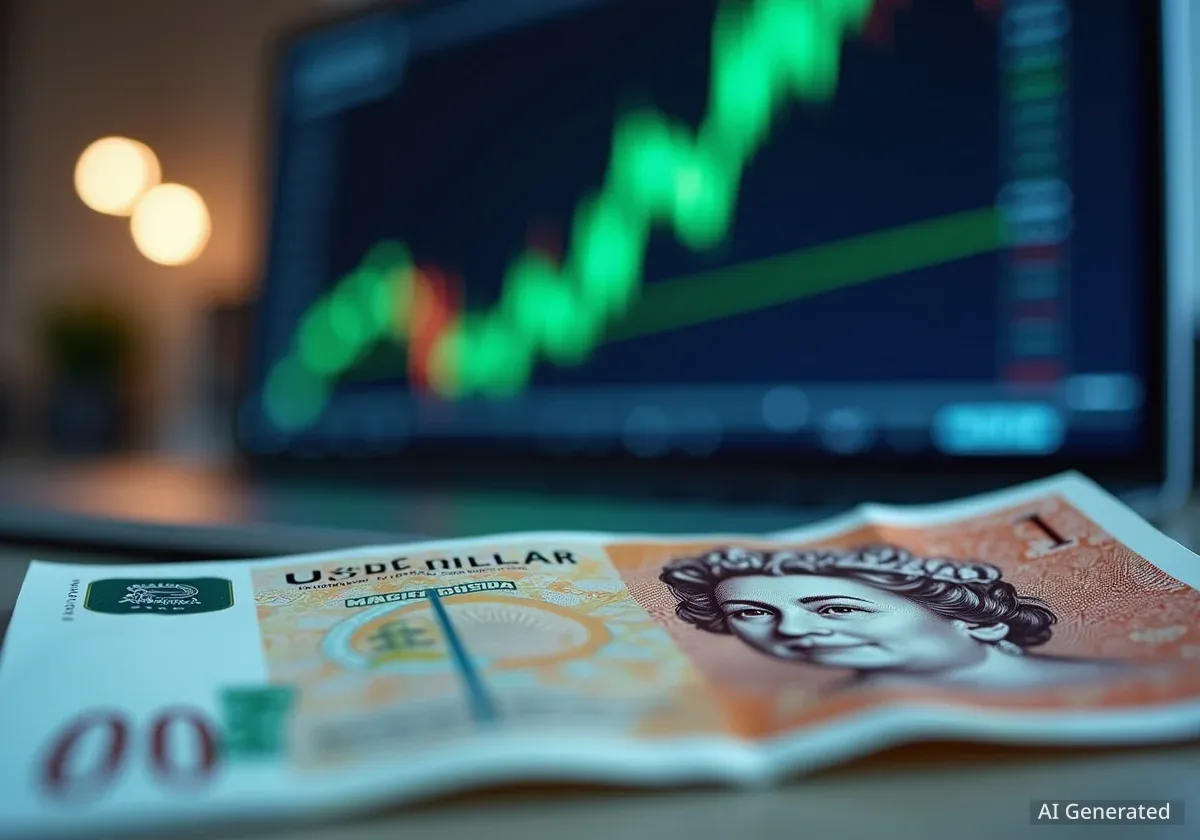The British Pound dropped to its lowest point in three weeks against the US Dollar on Thursday, falling below the key 1.3400 level. The decline was driven by a series of strong economic reports from the United States, which increased demand for the greenback and signaled underlying strength in the American economy.
The GBP/USD currency pair traded near 1.3366, marking a daily loss of approximately 0.60%. This movement reflects broader market trends where the US Dollar gained significant ground against a basket of major currencies, with investors reacting positively to better-than-expected economic indicators.
Key Takeaways
- The GBP/USD exchange rate fell to a three-week low, trading around 1.3366.
- Stronger-than-expected US economic data, including revised GDP and lower jobless claims, fueled the US Dollar's rally.
- The US Dollar Index (DXY) reached its highest level in several weeks, indicating broad strength.
- Comments from a Federal Reserve official suggested policy is appropriately restrictive but inflation remains a concern.
- Market attention is now focused on the upcoming US Core PCE inflation report for further clues on monetary policy.
US Economic Data Exceeds Expectations
A wave of positive economic data from the United States was the primary catalyst for the US Dollar's appreciation. The reports painted a picture of a resilient economy, easing some concerns about a potential slowdown and reinforcing the dollar's status as a safe-haven asset.
The most significant release was the revised Gross Domestic Product (GDP) figure for the second quarter. The data showed the US economy expanded at an annualized rate of 3.8%, a sharp upward revision from the initial estimate of 3.3%. This figure comfortably surpassed market forecasts and suggested economic activity was more robust than previously thought.
Key US Economic Indicators
- Q2 GDP Growth (Revised): 3.8% (Previous: 3.3%)
- Initial Jobless Claims: 218,000 (Forecast: 235,000)
- Durable Goods Orders (August): +2.9%
Further bolstering the positive sentiment, weekly Initial Jobless Claims fell to 218,000. This was lower than the anticipated 235,000 and a decrease from the prior week's 232,000, indicating a healthy labor market. Additionally, Durable Goods Orders for August rebounded strongly, rising by 2.9% after a significant drop in the previous month.
Sterling Slides Amid Dollar Strength
The British Pound bore the brunt of the US Dollar's renewed vigor. The GBP/USD pair's fall below the 1.3400 psychological level is a significant technical development for traders. This move pushed the pair to its lowest valuation since the first week of September.
The dollar's strength was not isolated to its pairing with the pound. The US Dollar Index (DXY), which measures the greenback's value against a basket of six major currencies, climbed to 98.30. This was its highest point since September 5, demonstrating the widespread demand for the US currency.
What is the US Dollar Index (DXY)?
The DXY is a widely followed benchmark for the international value of the US Dollar. It represents a weighted average of the dollar's value relative to a basket of currencies, including the Euro, Japanese Yen, British Pound, Canadian Dollar, Swedish Krona, and Swiss Franc. A rising DXY indicates the dollar is strengthening against these currencies.
For the pound, the move was particularly sharp, making it one of the weakest-performing major currencies on the day. The market dynamic was clear: capital flowed towards the dollar as the economic outlook for the U.S. appeared brighter than for many of its peers.
Federal Reserve Commentary and Inflation Focus
Adding another layer to the market narrative, Kansas City Federal Reserve President Jeffrey Schmid provided commentary on the state of monetary policy. He described the current policy stance as "slightly restrictive," which he believes is the correct approach for the economy at this time.
"Monetary policy remains slightly restrictive, which he described as the right place to be," Schmid stated on Thursday, acknowledging that inflation is "still too high."
Schmid also noted that the job market is "largely in balance" but cautioned about "rising risks" to employment. He suggested that a recent interest rate cut was an appropriate measure to mitigate these risks. His comments highlight the central bank's delicate balancing act between controlling inflation and maintaining full employment.
Despite the day's strong data, investors remain cautious ahead of a crucial inflation report. The Core Personal Consumption Expenditures (PCE) price index for August, scheduled for release on Friday, is the Federal Reserve's preferred measure of inflation. This report will be heavily scrutinized for signs that price pressures are either easing or persisting, which will directly influence the Fed's future interest rate decisions.
Market Outlook and Next Catalysts
The immediate outlook for the GBP/USD pair is heavily dependent on the upcoming US inflation data. A higher-than-expected PCE reading could further boost the dollar, as it might compel the Federal Reserve to maintain its restrictive policy for longer. Conversely, a softer inflation number could provide some relief for the pound and other currencies.
The inflation component within Thursday's GDP report already provided a modest surprise, with the core PCE price index for Q2 rising to 2.6% from 2.5%. This has set a slightly hawkish tone ahead of Friday's more timely August data.
Traders will be analyzing the PCE report to determine the likely path of monetary policy. The Federal Reserve has emphasized a data-dependent approach, making high-impact releases like this one pivotal for market direction. Until then, the US Dollar is likely to maintain its firm footing, keeping pressure on the British Pound and other major currencies.





